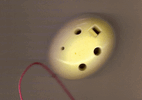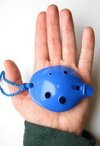blockarina
Registrierter Benutzer
- Zuletzt hier
- 20.05.17
- Registriert
- 22.07.13
- Beiträge
- 505
- Kekse
- 4.432
- - - Aktualisiert - - -
Hi Lisa,
also, die Thomann-4-Loch-Okarina ist eigentlich eine 6-Loch-Okarina ;-)
Es gibt 4-Loch-Okarinas mit unterschiedlichen Systemen/Griffweisen: viele südamerikanische Okarinas (z.B. aus Eine-Welt-Läden) sind zwar schön verziert bzw. bemalt, aber NICHT GESTIMMT (also nur Deko!). Wahrscheinlich sind alte Original-Okarinas aus Südamerika ursprünglich pentatonisch gestimmt. Fünfton-4-Loch-Okarinas (z.B. c-d-e-f-g) - wäre für kleine Kinder vielleicht einfacher (ich kenne aber keine gut gestimmte - vielleicht sollte ich mal eine bauen, die gut stimmt!
Ich meine die 4-Loch-Okarinas mit dem sogenannten "Englischem System", das der Engländer John Taylor (nach einer ungestimmten südam. 4-Loch-Okarina) 1963 entwickelte und mittlerweile die weitverbreitetste ist: Darauf ist eine diatonische Tonleiter/eine Oktave + 3 "Halbtöne" zu spielen, z.B. c-d-e-f-g-a-h-c' + fis, gis, ais/b.
http://johntaylorocarina.wordpress.com/2011/05/19/welcome/
http://www.clayz.com/baz/Make.html
John Taylor: "In the early part of 1963 I had the idea to make a pottery ocarina after seeing one in a second-hand shop.I took some advice from a local potter in Hampstead-Chris Maggarshak-who was a bit apprehensive about the shrinkage difficulties.I made six and they turned out alright.I discovered they would sell at Portobello Road.
From then on I found regular customers and made a wide variety of hand-made shapes of many sizes,including Birds,Dinosaurs and replicas of Museum pre-columbian pipes:-Aztec,Mixtec and Peruvian pan flutes and a Mochica Conch trumpet.
In mid 1963 I discovered the four-holed tuning by experimenting with unequal sized holes and cross-fingering to produce a small pendant with a full scale.
This system was later adopted by many makers-friends I had taught and people people in other countries who had come across such an instrument. Some of the people in the house I lived in in Camden Town made their living from making ocarinas at various times and visiting foreigners learned the craft and took it to their countries:sometimes they stayed in England and survived off ocarina sales."
http://en.wikipedia.org/wiki/Ocarina

http://www.ocarina.co.uk/whole-class-ocarinas/
http://alfafox.info/okarina.htm

Ich weiß nicht, ob die Okarina bei Amazon (mit Anleitungheft) etwas taugt (ich habe sie mir mal bestellt - dann kann ich darüber berichten):
http://www.amazon.de/Instrumentense...85670108&sr=1-1&keywords=Mini+Trainer+Okarina
Das John-Taylor-System ist eher für etwas ältere Kinder geeignet, da die Tonleiter durch Kombination der Löcher erzeugt wird, das erfordert anfangs etwas Übung - aber die 4 Löcher sind überschaubar.
Eine meiner Bekannten hat aber auch Vorschulkinder damit unterrichtet.
blockarina
P.S. John Taylor ist schon vor einigen Jahren gestorben!
Hi Lisa,
also, die Thomann-4-Loch-Okarina ist eigentlich eine 6-Loch-Okarina ;-)
Es gibt 4-Loch-Okarinas mit unterschiedlichen Systemen/Griffweisen: viele südamerikanische Okarinas (z.B. aus Eine-Welt-Läden) sind zwar schön verziert bzw. bemalt, aber NICHT GESTIMMT (also nur Deko!). Wahrscheinlich sind alte Original-Okarinas aus Südamerika ursprünglich pentatonisch gestimmt. Fünfton-4-Loch-Okarinas (z.B. c-d-e-f-g) - wäre für kleine Kinder vielleicht einfacher (ich kenne aber keine gut gestimmte - vielleicht sollte ich mal eine bauen, die gut stimmt!
Ich meine die 4-Loch-Okarinas mit dem sogenannten "Englischem System", das der Engländer John Taylor (nach einer ungestimmten südam. 4-Loch-Okarina) 1963 entwickelte und mittlerweile die weitverbreitetste ist: Darauf ist eine diatonische Tonleiter/eine Oktave + 3 "Halbtöne" zu spielen, z.B. c-d-e-f-g-a-h-c' + fis, gis, ais/b.
http://johntaylorocarina.wordpress.com/2011/05/19/welcome/
http://www.clayz.com/baz/Make.html
John Taylor: "In the early part of 1963 I had the idea to make a pottery ocarina after seeing one in a second-hand shop.I took some advice from a local potter in Hampstead-Chris Maggarshak-who was a bit apprehensive about the shrinkage difficulties.I made six and they turned out alright.I discovered they would sell at Portobello Road.
From then on I found regular customers and made a wide variety of hand-made shapes of many sizes,including Birds,Dinosaurs and replicas of Museum pre-columbian pipes:-Aztec,Mixtec and Peruvian pan flutes and a Mochica Conch trumpet.
In mid 1963 I discovered the four-holed tuning by experimenting with unequal sized holes and cross-fingering to produce a small pendant with a full scale.
This system was later adopted by many makers-friends I had taught and people people in other countries who had come across such an instrument. Some of the people in the house I lived in in Camden Town made their living from making ocarinas at various times and visiting foreigners learned the craft and took it to their countries:sometimes they stayed in England and survived off ocarina sales."
http://en.wikipedia.org/wiki/Ocarina

http://www.ocarina.co.uk/whole-class-ocarinas/
http://alfafox.info/okarina.htm

Ich weiß nicht, ob die Okarina bei Amazon (mit Anleitungheft) etwas taugt (ich habe sie mir mal bestellt - dann kann ich darüber berichten):
http://www.amazon.de/Instrumentense...85670108&sr=1-1&keywords=Mini+Trainer+Okarina
Das John-Taylor-System ist eher für etwas ältere Kinder geeignet, da die Tonleiter durch Kombination der Löcher erzeugt wird, das erfordert anfangs etwas Übung - aber die 4 Löcher sind überschaubar.
Eine meiner Bekannten hat aber auch Vorschulkinder damit unterrichtet.
blockarina
P.S. John Taylor ist schon vor einigen Jahren gestorben!
Zuletzt bearbeitet:



